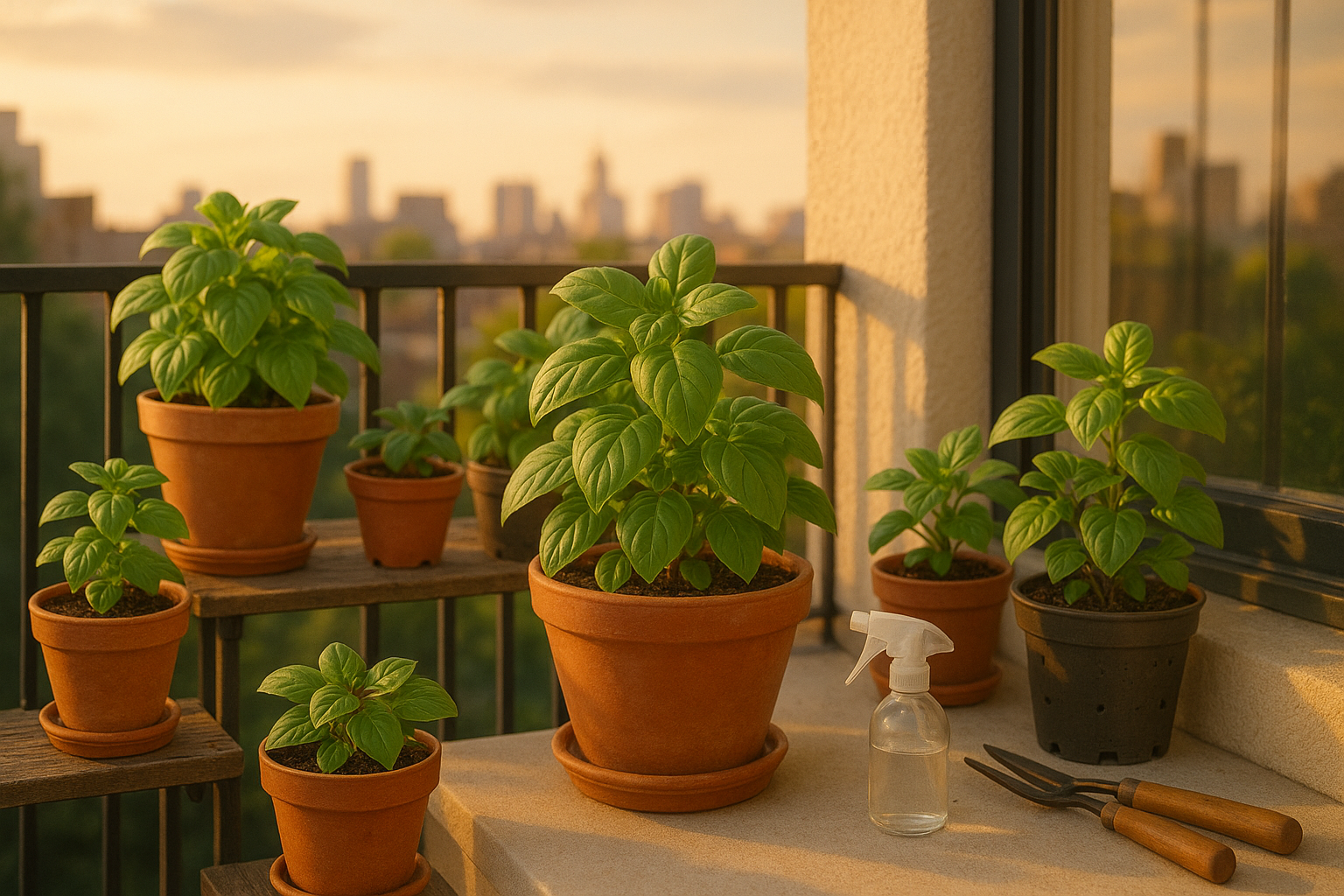Introduction to Growing Basil in Small Spaces
Growing basil on balcony setups has become a favorite trend among city dwellers and anyone short on outdoor gardening space. This aromatic, flavorful herb isn’t just a staple in classic recipes like pesto and Caprese salad — it’s also one of the easiest herbs for beginners and urban gardeners to grow at home. Whether you live in a compact apartment or just want to keep fresh herbs within reach, cultivating basil on your balcony or windowsill offers unbeatable convenience and a fragrant splash of green in your daily life.
Not only does this practice provide fresh leaves for cooking at a moment’s notice, but basil plants can also help purify indoor air, adding to the health and comfort of your living space.
Small-space gardening does come with its own set of challenges — think limited sunlight, variable temperatures, and the need for tidy container arrangements. However, with the right pot, good soil, and a sunny spot, growing basil in tight quarters is surprisingly simple. You don’t need fancy equipment or a green thumb to succeed. In fact, caring for basil is an ideal starting point for anyone new to herb gardening, turning even the narrowest balcony or tiniest windowsill into a thriving, edible retreat.
Choosing the Right Basil Variety for Your Space
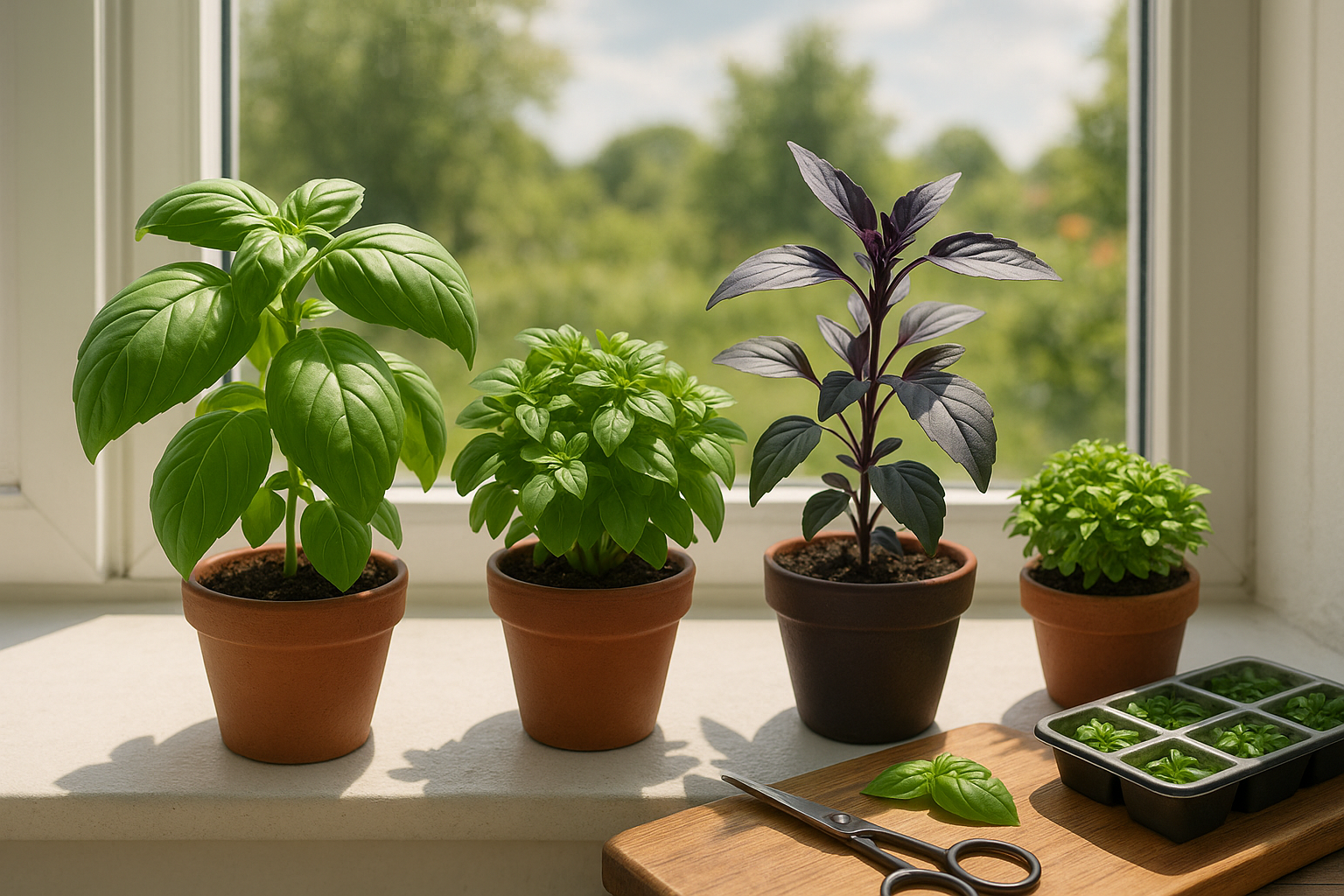
Picking the right basil variety can make all the difference when growing in containers, especially if you’re limited on space. Classic Genovese and Sweet basil are excellent all-purpose choices, delivering that familiar, aromatic punch perfect for pesto and salads. These varieties tend to grow robustly, with broad leaves and plants that can reach up to two feet if given enough room.
If space is tight or you want a window-sill kitchen garden, compact types like Greek basil or spicy Globe basil stay small—usually under 10 inches tall—and their bushy, dense growth makes them ideal for small pots. Thai basil is another wonderful option for those who love a peppery flavor twist, with narrower leaves and purple stems that add visual interest too.
When sourcing basil, check your local nurseries for starter plants in spring, which can give you a head start, or browse reputable online stores for a wider selection of seeds, including rare or organic varieties. Growing basil from seeds lets you enjoy the entire plant life cycle and choose from countless strains, but starter plants are unbeatable for beginners and those eager for a quicker harvest.
If you opt for seeds, use shallow trays and keep the soil moist until germination. For starter plants, select healthy specimens with vibrant foliage and no signs of disease.
No matter the variety, ensure your container has good drainage and a sunny windowsill or balcony spot. With a bit of planning, you can enjoy fresh, homegrown basil that fits both your taste buds and your available space.
Setting Up Containers and Soil for Success
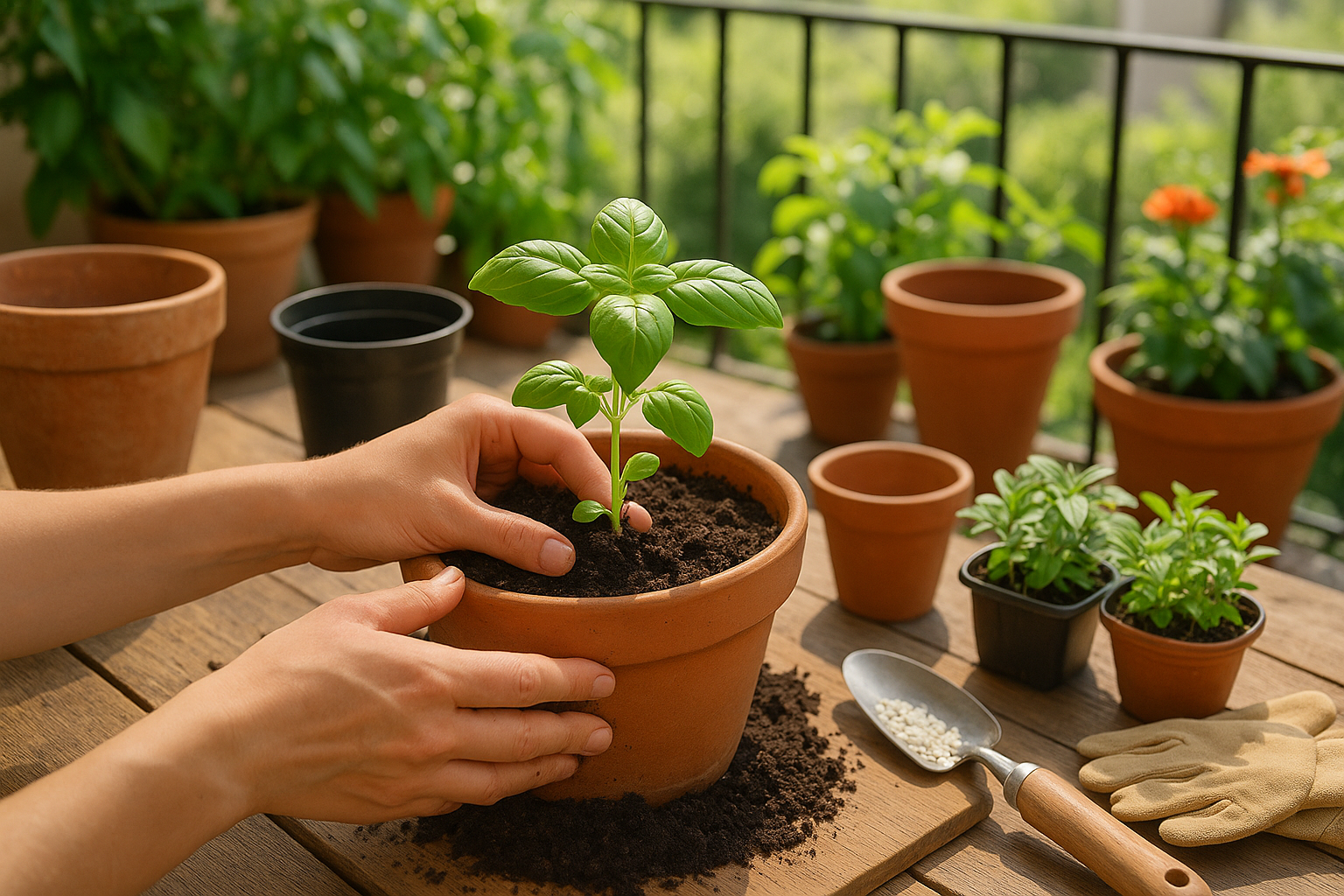
Choosing the right container is the first step to growing healthy plants. Look for pots that are at least 12 inches deep for most vegetables and herbs, as this allows roots to spread and thrive.
Material matters too: terracotta pots breathe well but dry out quickly, while plastic pots retain moisture—choose based on your local climate and your plant’s needs. Drainage holes are essential to prevent soggy roots and root rot, so make sure every pot has enough holes at the bottom.
For soil, skip regular garden dirt; instead, fill containers with a quality potting mix designed for containers. These mixes are light, well-draining, and often contain perlite or vermiculite for extra airflow. Mixing in a few scoops of well-rotted compost can boost fertility, giving your plants a hearty start.
When planting, read the labels for each plant’s recommended spacing and planting depth: place seeds or seedlings at the depth indicated, and leave enough room between each so they aren’t competing for nutrients. Water thoroughly after planting, and be aware that containers tend to dry out faster than garden beds; check soil moisture daily, especially during hot spells.
For larger containers, consider companion planting: grow basil and tomatoes together, or pair leafy greens like spinach and lettuce. These combinations can help deter pests and make the most of available space.
With the right setup, your container garden will have a strong start and reward you with healthy, productive plants all season.
Finding the Best Light and Location
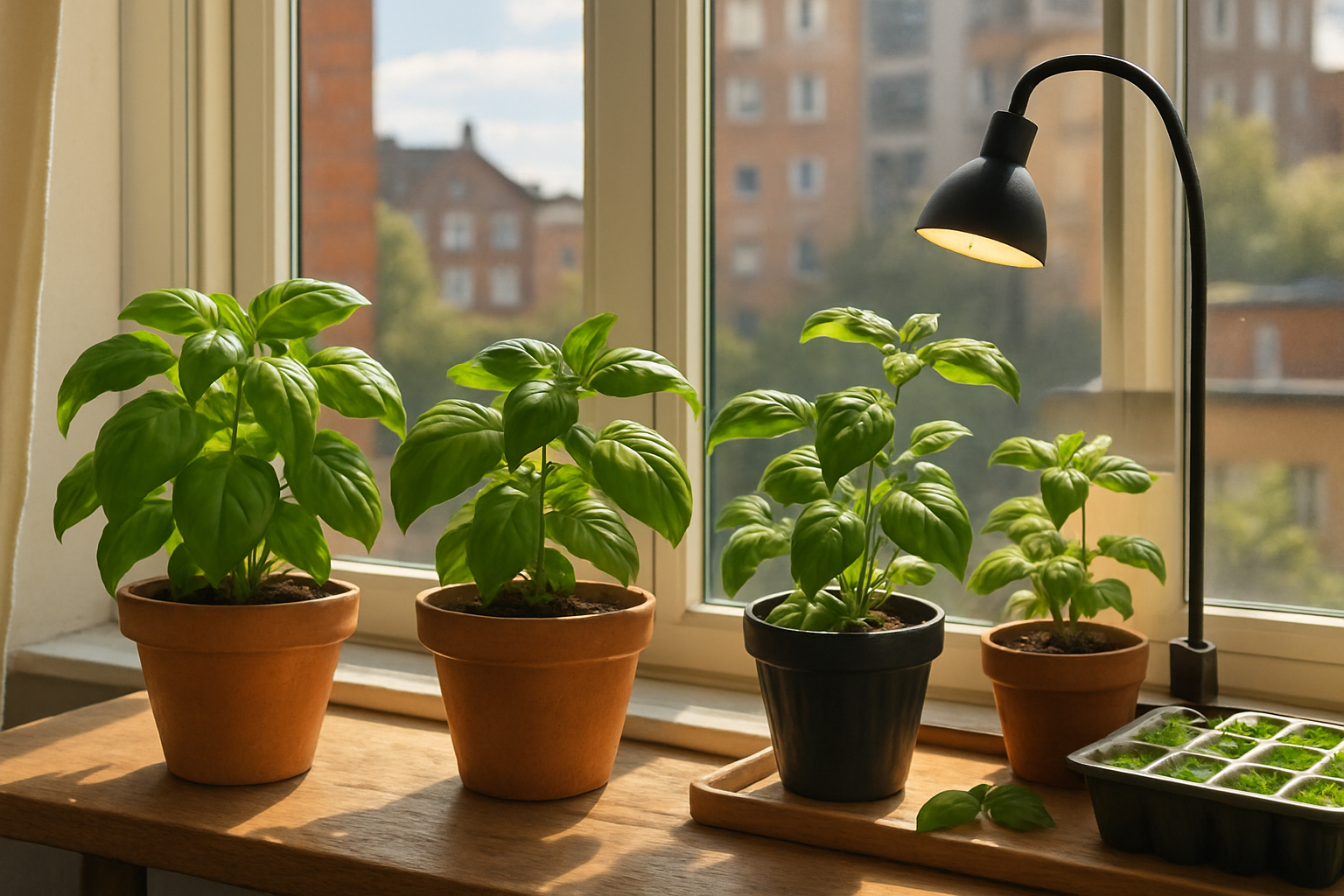
Basil truly thrives when it gets plenty of sun—aim for at least 6 hours of direct light each day. For urban gardeners, balconies and windowsills often make the most sense.
South-facing windows get the most sun, especially in the Northern Hemisphere, so placing your basil there gives it the best shot. East or west-facing windows can work too, but you may need to rotate the pot or move it throughout the day to maximize exposure.
In apartments or shaded spaces, consider using a grow light: place it about 6-12 inches above the plant and set it to run for 12-16 hours daily for optimal growth.
When seasons change, keep an eye on shifting sunlight patterns—what worked in summer may not in winter. Move your basil accordingly to keep it in that sunny sweet spot.
Watch for warning signs if the light isn’t right: pale or yellowing leaves and leggy, stretched stems indicate your plant is reaching for more sun. If this happens, move it to a brighter spot or supplement with a grow light.
Remember to rotate your plant every few days so all sides get equal light, encouraging even, bushy growth. If your only option is a north-facing window, a full-spectrum grow light is your best friend.
With these simple adjustments and attentive observation, you can enjoy vibrant, aromatic basil all year round, no matter where you live.
Watering, Feeding, and Everyday Care
Caring for your plants daily doesn’t have to be complicated, but consistency is key—especially when it comes to watering. Most houseplants thrive with soil that’s evenly moist but never soggy; sticking your finger about an inch into the soil is an easy way to gauge moisture before watering.
Be attentive to signs: drooping, wilted leaves or dry, crumbly soil point to underwatering, while yellowing leaves, a musty smell, or soil that stays wet several days suggest overwatering. Always use pots with drainage holes to prevent root rot.
Feeding is just as essential for healthy growth—during spring and summer, a balanced liquid houseplant fertilizer diluted to half-strength every 4-6 weeks works well, while compost tea offers a gentle, natural alternative. Avoid fertilizing in winter when growth slows.
Besides water and food, plants need good airflow. Cluster pots loosely and occasionally open nearby windows, ensuring they aren’t exposed to cold drafts.
Pruning or pinching leggy stems helps them grow bushier and prevents pests—just snip above a leaf node or where you want to encourage new growth. For species that lean toward light, such as pothos or rubber plants, rotating the pots every week helps all sides get even sun, resulting in healthier, fuller foliage.
Take a couple of minutes daily to check for pests, dust off leaves with a damp cloth, and keep an eye on their overall vigor. These simple habits keep your plants resilient and gorgeous with minimal fuss, making plant care not just a task, but a rewarding part of your daily routine.
Pruning, Harvesting, and Extending Your Basil Yield
To get the most from your basil, start harvesting leaves once the plant is about 6-8 inches tall and has several sets of leaves. Early and regular harvesting actually encourages basil to grow fuller and tastier—don’t be afraid to snip!
Use clean scissors or pinch off leaves just above a pair of healthy leaves; this helps the plant branch out, making it bushier. Focus on taking the top leaves first, as these are the most tender and flavorful. Always avoid removing more than a third of the plant at one time so it can recover and keep growing.
Pruning is also key: once stems have at least two or three sets of leaves, regularly pinch off the growing tips (the very top set of leaves), which stimulates the plant to send out new side shoots. Whenever you see flower buds starting to form, pinch them off immediately. Letting basil flower may seem lovely, but it signals the plant to stop making new leaves, reducing your yield.
For a longer harvest season, try succession planting—start new basil seeds or transplant seedlings every few weeks, so you always have young, productive plants coming up as older ones slow down. You can also grow basil indoors on a sunny windowsill as cooler weather arrives.
With these simple habits—timely harvesting, strategic pruning, and staggered planting—you’ll enjoy a lush, continuous supply of fresh basil for months.
Troubleshooting Common Problems (Pests, Diseases, and Bolting)
Growing your own vegetables comes with a few common hiccups—pests like aphids, diseases such as powdery mildew and root rot, and unexpected bolting, where plants “go to seed” too soon.
Watch for aphids clustering under leaves or powdery white spots, which signal mildew; both can be sent packing with a gentle spray of soapy water or neem oil. If you see roots turning brown and mushy, or leaves yellowing rapidly, you’re likely dealing with root rot, often caused by overwatering—let the soil dry out and trim affected roots to save your plant.
Temperature swings can also stress plants, leading to stunted growth or premature flowering (bolting), a sign especially common with lettuce, spinach, and cilantro. When you spot tall, flower-tipped stems, harvest what you can quickly or start a new batch in cooler weather.
Yellowing leaves and stunted growth usually spell trouble; don’t hesitate to snip off damaged foliage and boost plants with an organic compost tea for recovery.
Growers have the most success when they act fast—catch problems early, use organic remedies, and don’t be afraid to restart plants when issues get out of hand. Every challenge is a learning moment in the garden!
Preserving and Using Your Basil Bounty
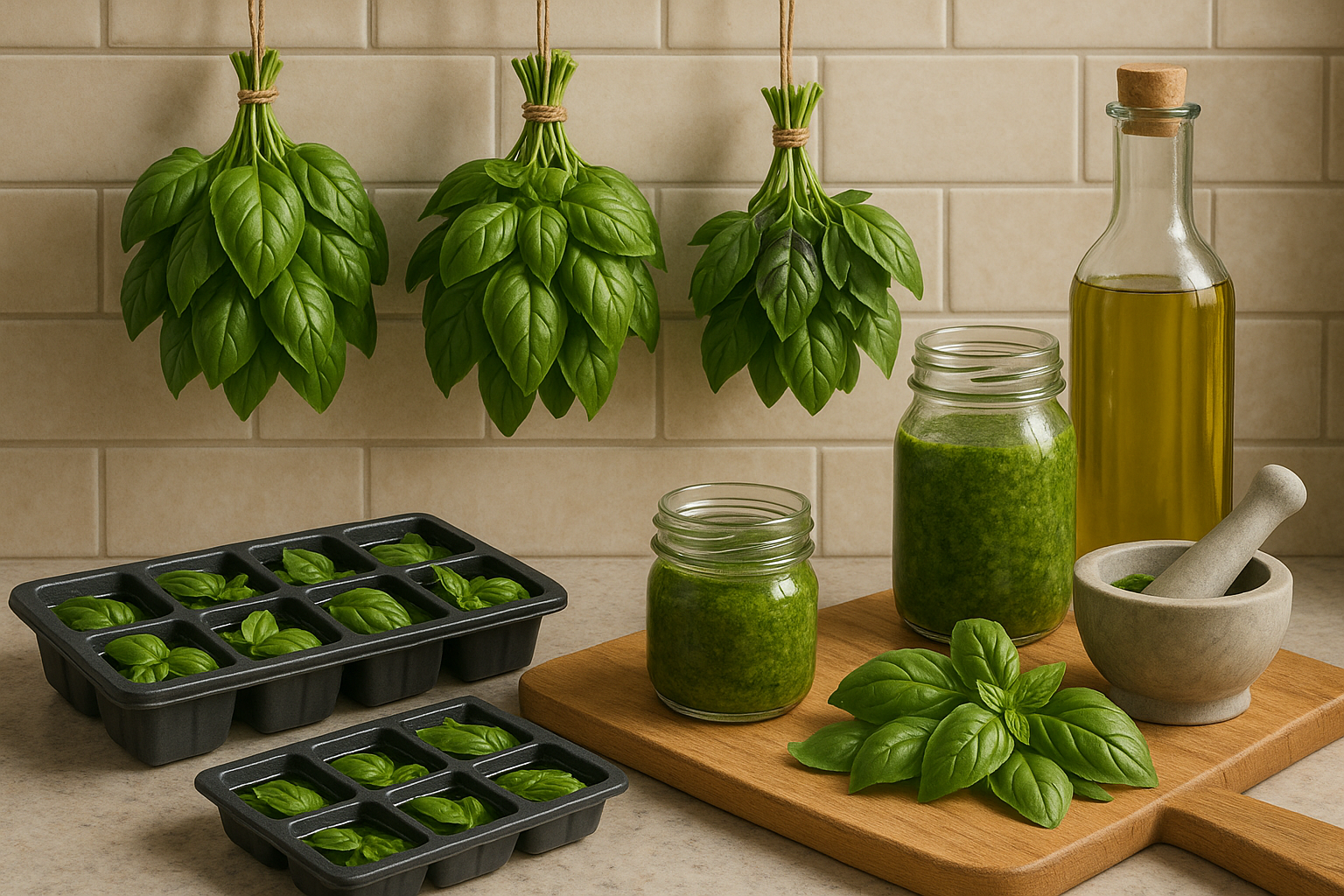
When your basil plants are flourishing, it’s easy to end up with more leaves than you can use at once. Luckily, preserving basil is simple and lets you savor its fresh taste all year long.
Try freezing whole basil leaves in ice cube trays with a splash of water or olive oil—perfect for tossing into soups and stir-fries straight from the freezer.
Another easy method is drying: simply tie stems in small bundles and hang them upside down in a cool, dry spot. Once dried, crumble and store the leaves in airtight jars for use in sauces or on pizza.
Homemade pesto is a perennial favorite—blend basil with garlic, nuts, olive oil, and Parmesan, then freeze in small containers for quick pasta tosses or sandwich spreads.
Basil-infused oil is another delicious way to preserve the herb; drizzle it over grilled veggies or mix it into salad dressings for a burst of fresh flavor.
While fresh basil is unbeatable tossed in tomato salads, layered on Margherita pizza, or stirred into omelets, don’t be afraid to get creative:
- Try it in lemonade
- Blend it into smoothies
- Even bake it into breads
Experiment with different techniques to keep enjoying that garden-fresh basil taste year-round, and have fun discovering new favorite ways to use your homegrown bounty.
